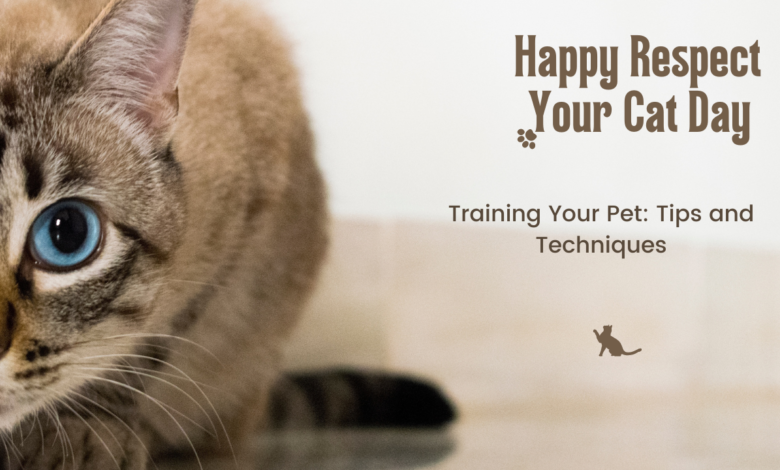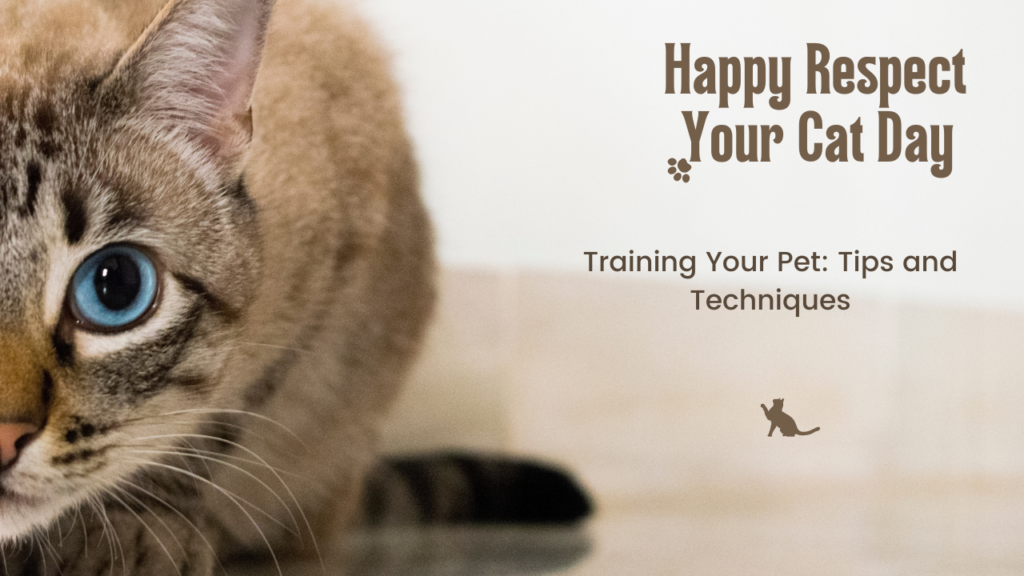
Introduction
Training your pet is an essential part of ensuring a harmonious relationship between you and your furry companion. Whether you have a dog, cat, bird, or even a small animal, proper training can help establish good behavior, prevent behavioral issues, and enhance the bond you share with your pet.

This article explores effective training tips and techniques for various pets, emphasizing positive reinforcement and consistency to achieve the best results.
The Basics of Pet Training
- Positive Reinforcement:
- Positive reinforcement is the most effective and humane method of training. It involves rewarding your pet for good behavior with treats, praise, or playtime. This approach encourages your pet to repeat the desired behavior and helps build a positive association with training sessions.
- Consistency:
- Consistency is key to successful training. Use the same commands and signals each time you train your pet. Ensure all family members are on the same page and follow the same training protocols to avoid confusion for your pet.
- Patience and Persistence:
- Training takes time and patience. Pets, especially young ones, may not grasp commands immediately. Be persistent and patient, and avoid punishing your pet for mistakes. Instead, redirect their behavior and reward them when they get it right.
- Short, Frequent Sessions:
- Keep training sessions short and frequent. Pets have limited attention spans, so 5-10 minute sessions a few times a day are more effective than long, infrequent sessions. This approach keeps your pet engaged and prevents frustration.
Training Techniques for Different Pets
- Training Dogs:
- Basic Commands: Start with basic commands such as “sit,” “stay,” “come,” and “down.” Use treats and praise to reward your dog when they follow the command correctly.
- Leash Training: Teach your dog to walk calmly on a leash. Use a leash and collar or harness, and reward your dog for walking beside you without pulling.
- House Training: Establish a routine for bathroom breaks. Take your dog outside frequently, especially after meals and naps, and reward them for eliminating outside.
- Crate Training: Crate training provides a safe space for your dog and can aid in house training. Introduce the crate positively, and never use it as punishment.
- Training Cats:
- Litter Box Training: Most cats naturally use a litter box. Place the box in a quiet, accessible location and keep it clean. Reward your cat with treats or praise for using the litter box.
- Scratching Posts: Encourage your cat to use scratching posts instead of furniture. Provide multiple posts and reward your cat for using them. Use deterrents like double-sided tape on furniture to prevent scratching.
- Clicker Training: Clicker training can be effective for cats. Use a clicker to mark desired behaviors and follow up with a treat. This method can teach tricks and reinforce positive behaviors.
- Training Birds:
- Step-Up Command: Teach your bird to step onto your finger or a perch on command. Use a treat to lure the bird onto your finger and reward them for complying.
- Speech Training: Some bird species, like parrots, can learn to mimic words and sounds. Repeat the words you want your bird to learn and reward them when they attempt to mimic.
- Target Training: Use a target stick to guide your bird to specific locations. Reward your bird for touching the target stick with their beak. This technique can be used for various training purposes.
- Training Small Animals:
- Rabbits: Train your rabbit to use a litter box by placing the box in their enclosure and rewarding them for using it. Use treats and gentle guidance for other behaviors, like coming when called.
- Guinea Pigs: Guinea pigs can learn to come when called and perform simple tricks. Use treats and consistent commands to encourage desired behaviors.
- Hamsters: Handle your hamster gently and frequently to tame them. Use treats to reward calm behavior and teach simple tricks like standing on their hind legs.
Common Training Challenges and Solutions
- Biting and Nipping:
- Dogs and Puppies: Redirect biting behavior to chew toys. If your puppy bites during play, say “no” firmly and offer a toy instead. Avoid rough play that encourages biting.
- Cats and Kittens: Provide appropriate toys for biting and play. If your cat bites during petting, stop the interaction and give them space. Reward gentle behavior with treats and affection.
- Jumping:
- Dogs: Teach your dog to sit when they greet people. Ignore jumping behavior and reward your dog when they sit calmly. Consistency from all family members and visitors is crucial.
- Cats: If your cat jumps on counters or furniture, provide alternative climbing options like cat trees. Use deterrents like aluminum foil on surfaces you want to keep off-limits.
- Barking and Meowing:
- Dogs: Identify the cause of excessive barking and address it. Teach the “quiet” command by rewarding your dog for stopping barking on command. Ensure your dog gets enough physical and mental stimulation.
- Cats: Excessive meowing can indicate a need for attention or medical issues. Ensure your cat’s needs are met, and consult a veterinarian if the behavior persists. Ignore attention-seeking meows and reward quiet behavior.
- Fear and Anxiety:
- Desensitization: Gradually expose your pet to the source of their fear in a controlled manner. Reward calm behavior and increase exposure slowly.
- Counter-Conditioning: Pair the fearful stimulus with positive experiences, like treats or playtime. This helps change your pet’s emotional response to the stimulus.
Advanced Training and Enrichment
- Agility Training for Dogs:
- Agility training provides physical and mental stimulation. Set up an obstacle course with jumps, tunnels, and weave poles. Use positive reinforcement to guide your dog through the course and gradually increase the difficulty.
- Trick Training:
- Teaching tricks is fun and mentally stimulating for pets. Start with simple tricks like “shake” or “spin” and gradually introduce more complex ones. Use treats and praise to reward your pet’s efforts.
- Interactive Toys and Puzzles:
- Provide interactive toys and puzzles to challenge your pet mentally. Food-dispensing toys, puzzle feeders, and training games keep your pet engaged and mentally sharp.
Conclusion
Training your pet is a rewarding experience that enhances the bond between you and your companion. By using positive reinforcement, consistency, and patience, you can teach your pet good behavior and even some impressive tricks. Remember that each pet is unique, and what works for one may not work for another. Tailor your training approach to suit your pet’s personality and needs, and always celebrate their progress and achievements. With dedication and love, you’ll have a well-trained and happy pet that brings joy to your life.




